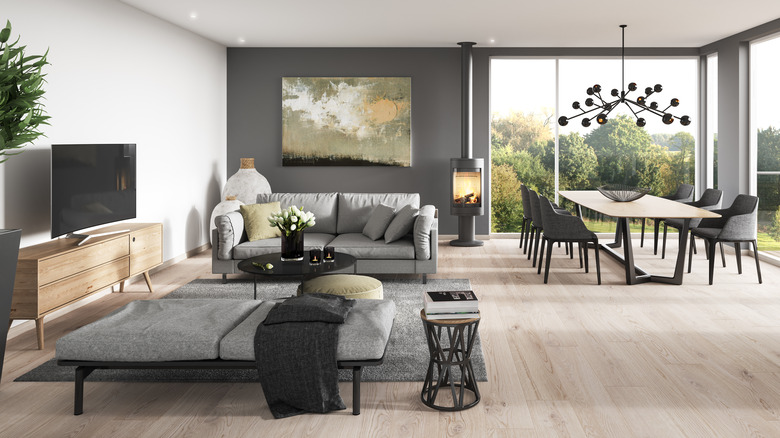The Beautiful Home Color Scheme HGTV's Heather El Moussa Can't Get Enough Of
Heather El Moussa may be known for selling homes, but on HGTV's "The Flipping El Moussas," she showcases that she also knows how to design homes that sell. With the hit HGTV set to return for a second season, viewers and buyers have responded well to El Moussa's modern designs, color schemes, and home and decor selections. Her favorite color scheme uses neutrals with dark undertones to create a signature look — dark and moody. While other designers gravitate toward clean and minimalist interior aesthetics, the ever-popular modern farmhouse style home, or homes with vintage-inspired retro decor, El Moussa's designs are anything but temporarily trendy.
On HGTV, Tarek and Heather El Moussas' flipped homes display the couple's preference for a sleek and contemporary California style. Heather El Moussa has fallen in love with the design side of house flipping, and she isn't afraid to put her twist on the duo's projects. The audacious dark and neutral color palette is one that the agent-turned-designer can't get enough of. "Between being a luxury real estate agent and being super involved in our flips, my love for home design has grown so much and I've genuinely fallen in love with the process," she shared on Instagram. "I gravitate towards neutrals with dark undertones but I also fall in love with new styles daily." Below, we dive into why Heather El Moussa loves this color scheme, how she utilizes it in her designs, and how to incorporate it into your home.
A moody twist on neutrals
Heather El Moussa's designs highlight the subtle elegance of dark elements set against a neutral backdrop. In her home, she uses deepened shades to create a luxurious modern look, while neutrals keep things warm and welcoming. In the living room, white walls and natural brown floors set the stage. The room is brought to life by the focal point: a fireplace with a black iron frame and floor-to-ceiling textured coal wallpaper. Dark undertones also appear on the gray couch, dual-tone black and ashen rug, and steely slate accent tables.
On HGTV's "The Flipping El Moussa's," the first flip project from season 2 also utilizes El Moussa's signature style. The couple posted photos of the home on Instagram, which features an open kitchen and dining room floor plan with black appliances, black tile backsplash, and monochrome patterned wallpaper. These bold selections are balanced with a natural wood table, cabinets, and floating shelves. The color scheme of black and grey, balanced by neutrals and natural wood textures, runs through every room in the house to create a livable luxury look. El Moussa's home and her recent HGTV projects highlight her preference for this design and her ability to execute it with stunning results. Even with all the dark colors, the star produces a warm and inviting atmosphere. Although El Moussa makes it look easy, designers know that working with dark colors in a home can often pose unique challenges.
How to use dark undertones
Even when offset by neutrals like cream or beige, a color scheme with too many dark undertones and finishes can make a space look frigid and unwelcoming. El Moussa sidesteps this issue by understanding how undertones create warmth or coldness and by using both to balance her design. Undertones are found in all colors other than true white, true black, and primary colors. When colors are made by mixing multiple shades, there is a masstone, which refers to the color you immediately see, and an undertone, which is the subtle influence of the main color mixed in to create that shade. Dark undertones like blue, green, and purple hide behind gray and black to create a cool feel.
Since El Moussa's designs rely heavily on black and gray, she balances her dark, cool shades with neutrals like white and beige, which contain warm undertones of pink, beige, or yellow. She also adds warmth with textiles like tufted chairs, textured headboards, rugs, blankets, and pillows. Although undertones may be difficult to understand, identifying a color's undertone is essential. Misunderstanding this design principle is often why a space doesn't turn out as harmonious as expected. Fortunately, if you're set on pairing neutrals and dark shades, there are many tools to set you up for success. Paint professionals, online tips from interior designers, and easy tests to help you determine paint undertones can give you the confidence to steal El Moussa's signature look.

